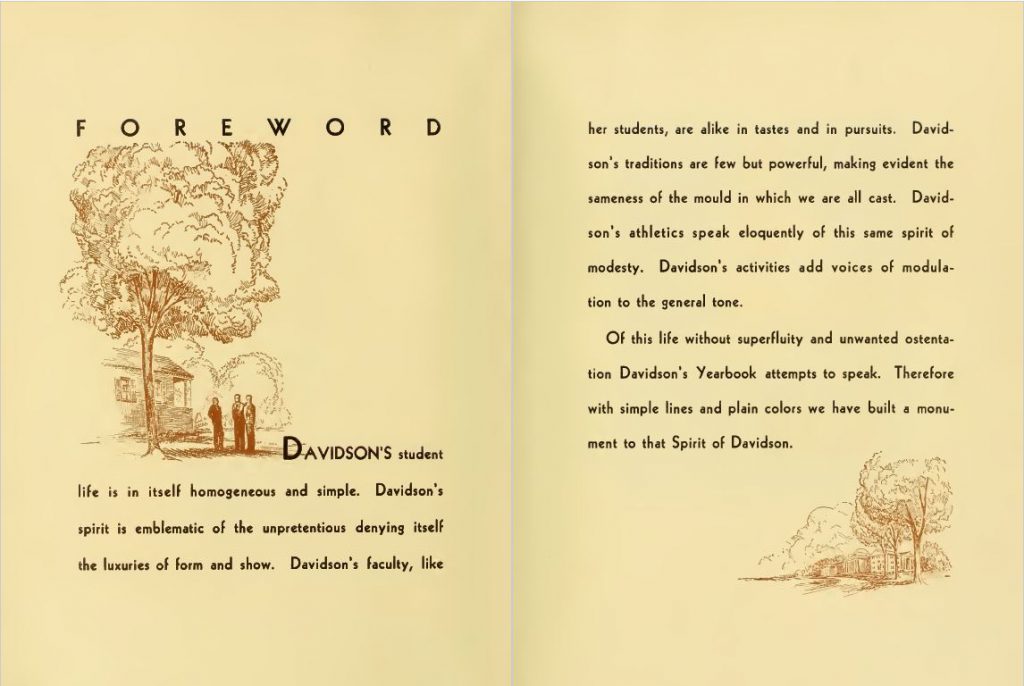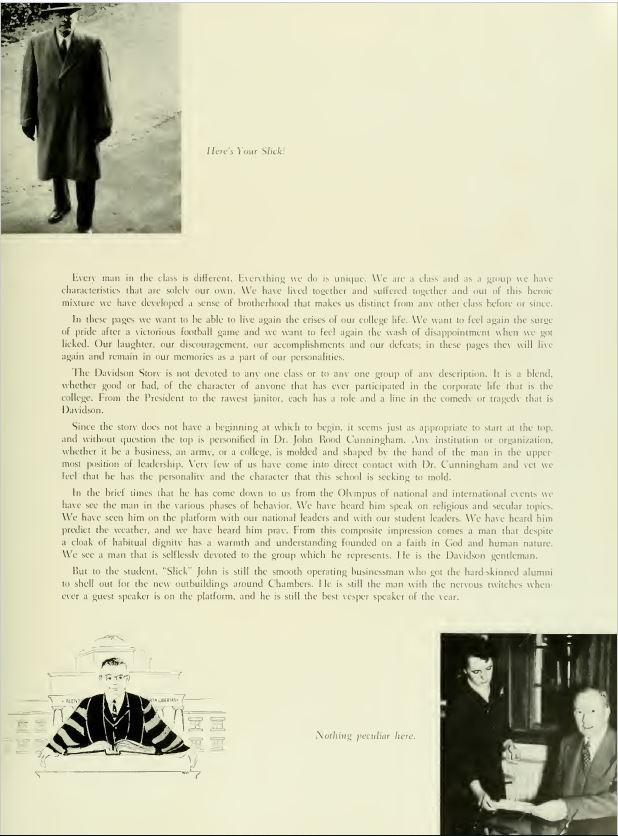Hello! I’m Hannah Foltz, class of 2013 and current PhD student in rhetoric at the University of Texas at Austin. This summer, I’m working with the Humanities program and the Archives and Special Collections team. I’ll be scouring the College’s archives, documenting and studying depictions and erasures of marginalized populations in historical materials. Because of my disciplinary background, I am most interested in the archives’ rhetorical role, or in other terms, how the records and materials we deem worthy of saving define the im/possibilities of not only historiography, but also of popular conceptions of identity and belonging.
My posts this summer have focused on the lack of neutrality in historical records and articles, such as Davidson’s yearbooks and newspapers. We’ve discussed how editorial choices—to include, to omit, how to frame—affect the historical record. This week, however, I’ll turn my attention to the construction of the archive itself; how we must understand it not as a complete and impartial repository, but as a composition that reflects the intentions, priorities, and ethics of those tasked with creating, maintaining, and displaying it.
The 1968–1969 school year was a pivotal one for Davidson; it saw the abolishment of compulsory ROTC (“Board Follows Faculty Lead, Assents to Voluntary ROTC,” p.1), anti-war protests (“Peace Group, Navy Vie,” p. 6), the presidential election (“The Davidsonian Report: Election–1968,” p. 3), murmurs about coeducation (“Coeducation Gets Overwhelming Support in Student-Faculty Poll”, p.1), the end of campus curfew (“Faculty Vote Opens Dorm Doors,” p. 1), the town going “wet,” (“State ABC Board Approves Permit,” p. 1) and ongoing criticism of the treatment of black students at Davidson (“Black Students in an Ivory Tower,” p. 3). While auditing the physical collection of that year’s Davidsonians, I hit a snag. An entire issue was missing! April 11th’s paper was not included in the bound collection; however, subsequent references to the issue confirmed that not only did it exist, but that it also upset many members of the community.
Letters to—and from—the editors suggested that an inflammatory letter to the editor had been published, one that had contained a personal attack. Elizabeth Smyre of Gastonia writes to say, “To include ‘good taste’ as a criterion for publication is an example of responsible editing” (Davidsonian, 2 May 1969, p.2). Mrs. Frontis Johnston, wife of the dean of faculty, comments that she has “never before read columns of such incredible rudeness” (Davidsonian, 18 April, p.2). The editors promise that, because of the furor, they would no longer publish letters to the editor that “constitute personal attacks”(Davidsonian, 18 April, p. 2).
I assumed the archival omission of this hot-button item was merely a mistake. The library keeps two bound collections of each year’s Davidsonians; maybe only one copy had been saved for binding? However, when consulting the volume that is not available for public browsing, I found the same gap.
My mind swirled with possibilities: what on earth was the archive hiding? Criticism of the administration? Offensive comments by a professor? Publication of a malicious rumor? Driven by curiosity, I asked Sharon Byrd—Davidson’s “Institutional Memory”—about the omission. She was able to point me to a scan of the microfilm of the April 11th issue. What I found answered some questions, but raised new ones.
The item that had caused so much tumult was a letter to the editor from a Taylor Adams of New York City. Mr. Adams, an advertising executive, writes after viewing the Davidson team compete in the GE College Bowl, a popular televised trivia show. To avoid amplifying Adams’ objectionable statements, I’ll paraphrase his comments: he expresses disdain for the team captain’s North Carolina accent, explaining that, in his view, such a dialect represents stereotypes Southerners have tried to overcome. Mr. Adams minces no words and manages to malign not only the College Bowl captain, but also Davidson, the state of North Carolina, and the black community.
The preservation of a microfilm, but not a physical, record of this letter is peculiar. We’re not sure who made decisions about binding in 1961, and to be clear, we’re not certain that the omission was purposeful. However, if we speculate that it was, what would such a choice indicate? My hunch is that although this person(s) recognized the necessity of keeping a complete record, they hesitated to place an ad hominem attack on a student in the library’s browsing collection. It’s an understandable example of an intervention made in the name of ethics. But was it the right one? Although the omission prevented circulation of a malicious screed, it also obscured reality, making it more difficult for a historian of the institution to access the full record.
As is often the case in the presentation of historical texts (or statues, plaques, etc), the addition of context and framing could go a long way in mediating the frequently conflicting pressures of ethics and historical transparency. Rather than present Mr. Adams’ offensive words in a relative void, one solution could be to redact them from the printed copy, but include directions for accessing them digitally and a short explanation that the redacted item contains objectionable material.
What do you think? If the omission was purposeful, was it the right choice? Should anything be redacted or omitted from the record—even if has the potential to hurt or offend? What kind of context should frame objectionable material?





